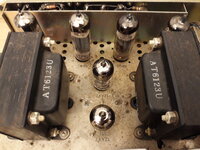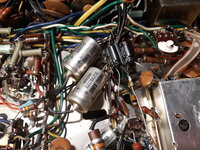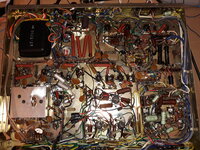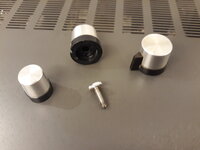-

pioneer er-420


 
 
|
Most
Pioneer models from the late 1960s had names starting with
the letters SX and two or three numbers after them. There
were also SX models sold as LX. However, ER-420 had a
completely different name. Visually, the ER-420 was
similar to the SX-800 series models, except that it had a
characteristic black and silver front panel.
Electronically, the ER-420 was a newer version of the
SX-40. The type of FM head has been changed, as well as
the type of MPX decoder, and a few minor changes have been
made. The audio path remained virtually unchanged.
According to the manufacturer, the power was 15 W per
channel in sine and 20 W per channel. 8 or 16 ohm column
resistance. The power amplifier worked on two pairs of
6BQ5 / EL84 tubes in a Push & Pull arrangement with
automatic bias. At the same time, the bias voltage was
also used to stabilize the heating of the 12AX7 / ECC83
tubes in the correction preamplifier for a magnetoelectric
turntable. The power stage was powered by a voltage
doubler system. The output tubes drove another 12AX7 /
ECC83. Pioneer used 6AN8A or 12AX7 drivers, depending on
the type of bias. The preamplifier also featured the
12AX7, which greatly simplified the servicing of the
receiver. The receiver had standard adjustments and
filters - "High Filter" - is a high-cutoff, "Low Filter"
is a low-cutoff and "Loudness" means dynamics. A separate
switch was used to disconnect the speakers when connecting
headphones - "Speaker On / Off". An interesting fact was
the use of the "MODE Stereo / Left mono / Right mono"
channel switch in the device. It probably resulted from
the possibility of working with the so-called tape
transport, i.e. a tape recorder with only heads - "Tape
Head". The ER-420 had a modular MPX matrix decoder with
the symbol AM0103A on two tubes 6AQ8 / ECC85 and one 6AV6
/ EBC91 pentode. A neon bulb served as an indicator of the
stereo signal. It worked properly with good separation.
The FM head with the symbol AM0111U was also unified. 6C9
It was a double noval tetrode with an additional tenth
output in the middle of this noval. Such a base - bore
the symbols B10G or E10-73. This double tetrode enabled a
three point VHF tuning which reduced the number of tubes
from 2, e.g. ECC85 to one 6C9. The head for one "lamp" had
excellent sensitivity and separation. 6C9 are still
available and at the same time inexpensive. The receiver
enabled also the reception of medium waves - AM. The
design of the ER-420 is very correct, the amplifier
confirms the positive opinions about Pioneer's Push &
Pulls on the EL84, and the very characteristic look is
eye-catching.
 
|
Main page
Previous page
Contact
|